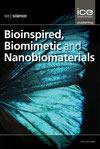骨组织工程用氟磷酸盐生物玻璃:体外和体内研究
IF 0.6
4区 工程技术
Q4 ENGINEERING, BIOMEDICAL
引用次数: 0
摘要
本研究的目的是研究氟化物对磷酸盐生物玻璃生物活性的影响,以用于骨组织工程。采用熔体淬火技术,在45P2O5-(30-X)- cao - 25na20 - xcaf2 (X = 0、1.25、2.5、3.75和5.0)的磷酸盐基玻璃中改变氟含量,制备了氟磷生物玻璃体系。用x射线光电子能谱法研究了制备材料的元素组成和氟保留率。模拟体液(SBF)生物活性试验显示磷灰石层及其骨结合能力,并通过x射线衍射图和傅里叶变换红外光谱进行了表征。生物玻璃对人胃腺癌(AGS)和MG-63细胞的生存能力证实了其无毒性质。体内研究证实了兔股骨髁中氟磷酸盐玻璃向骨的转化。10周后,通过扫描电子显微镜、能量色散x射线光谱仪(SEM_EDAX)和激光共聚焦扫描显微镜对骨-玻璃界面和骨吸收速率进行定性和定量观察。因此,在不久的将来,氟磷酸盐生物玻璃的生物相容性和生物可吸收性可以作为一种潜在的骨移植替代品。本文章由计算机程序翻译,如有差异,请以英文原文为准。
Fluorophosphate bio-glass for bone tissue engineering: in vitro and in vivo study
The objective of the work is to investigate the influence of fluoride in the bioactivity of phosphate bio-glass to utilise in bone tissue engineering. The fluorophosphate bio-glass system was formulated by varying fluoride content in phosphate-based glass 45P2O5-(30-X)-CaO-25Na2O-XCaF2 (X = 0, 1.25, 2.5, 3.75, and 5.0) using melt quenching technique. The elemental composition and fluoride retention in the prepared material was investigated by X-ray photoelectron spectroscopy. The bioactivity test in simulated body-fluid (SBF) exhibited apatite layer and its bone bonding ability which was characterized by X-ray diffraction patterns and Fourier Transform Infrared Spectrophotometer spectra. The viability of human gastric adenocarcinoma (AGS) and MG-63 cells of the bio-glass confirmed the nontoxic nature. In vivo studies demonstrated the conversion of the fluorophosphate glass to bone in the femoral condyle of the rabbit. After ten weeks, scanning electron microscope with energy dispersive X-ray spectrograph (SEM_EDAX) and confocal laser scanning microscopy examinations revealed the resorption rate and bone-glass interface qualitatively and quantitatively. Consequently, the biocompatible and bioresorbable nature of the fluorophosphate bioglass can be exploited as a potential bone graft substitute in the near future.
求助全文
通过发布文献求助,成功后即可免费获取论文全文。
去求助
来源期刊

Bioinspired Biomimetic and Nanobiomaterials
ENGINEERING, BIOMEDICAL-MATERIALS SCIENCE, BIOMATERIALS
CiteScore
2.20
自引率
0.00%
发文量
12
期刊介绍:
Bioinspired, biomimetic and nanobiomaterials are emerging as the most promising area of research within the area of biological materials science and engineering. The technological significance of this area is immense for applications as diverse as tissue engineering and drug delivery biosystems to biomimicked sensors and optical devices.
Bioinspired, Biomimetic and Nanobiomaterials provides a unique scholarly forum for discussion and reporting of structure sensitive functional properties of nature inspired materials.
 求助内容:
求助内容: 应助结果提醒方式:
应助结果提醒方式:


